How To Change To Rgb In Photoshop

Essential Photoshop Colour Settings
Open up your images to a profoundly expanded world of colour with i simple but important modify to the Color Settings in Photoshop. Learn virtually color spaces, working spaces, the default sRGB color space, and why Adobe RGB is a amend choice.
Adobe Photoshop is the globe'southward nigh powerful and popular image editor. As photographers, nosotros trust Photoshop to help our photos look their very best. So information technology may surprise you to learn that Photoshop'southward default color settings are preventing your photos from looking the mode they should. The color settings in Photoshop determine the range of colors available to u.s.a. when nosotros edit our images. More than colors mean more potential detail in our photos. More colors likewise requite us access to richer, more vibrant and more than saturated colors. And better looking colors hateful better looking images, both on screen and in impress.
Yet Photoshop's default color settings won't give you more colors. In fact, the default settings give you fewer colors. In this tutorial, we'll wait at why Adobe thinks that fewer colors are meliorate. We'll larn where to find Photoshop'southward colour settings then we can change them. And we'll look at the one important setting we need to modify to expand our range of colors and help our images expect even improve. I'll be using Photoshop CC but the color settings in Photoshop are the aforementioned now every bit they've been for years. Then if y'all're using Photoshop CS6 or earlier, you can hands follow along.
This is lesson 5 of 8 in Chapter one - Getting Started with Photoshop.
Let'south get started!
Where To Discover Photoshop's Color Settings
In Photoshop, the colour settings are found under the Edit menu. Get up to the Edit menu in the Carte Bar along the top of the screen. Then, choose Color Settings:
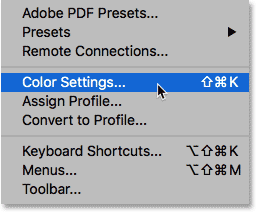
To open the colour settings, become to Edit > Color Settings.
The Color Settings Dialog Box
The Color Settings dialog box will open. If you've never seen the the Color Settings dialog box before, information technology can look intimidating at first. Simply as we'll see, most of Photoshop's default colour settings are fine. In fact, in that location's really only ane setting nosotros need to modify:
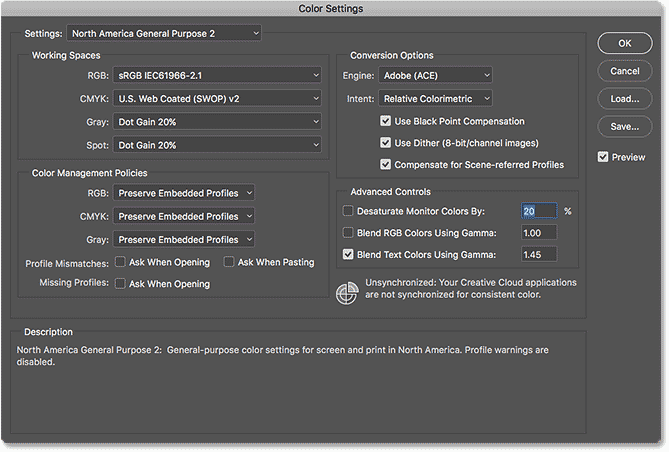
Photoshop's Colour Settings dialog box.
The New Darker Dialog Box
The Color Settings dialog box may look different on your screen depending on which version of Photoshop yous're using. Adobe fabricated dialog boxes darker in the most recent versions of Photoshop CC. Photoshop CS6 and earlier uses lighter dialog boxes. The particular shade of grayness you're seeing makes no departure. The color settings are the same.
Besides, in Photoshop CS6 and earlier, some of the more than advanced color settings are hidden by default. You tin can admission them by clicking the More Options button. Even so, we don't demand to change any of the advanced options, so you lot can safely get out them hidden.
The Default Color Settings Preset
Past default, Photoshop uses a preset collection of color settings known as North America Full general Purpose 2. If you're in a different role of the world, your preset may be named something different. If information technology is, that's okay because we'll be making our own change anyway:
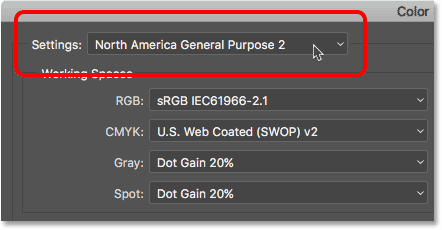
The default "N America Full general Purpose ii" preset.
Photoshop's Working Spaces
If we look direct below the name of the preset, nosotros detect the Working Spaces department. A working space tells Photoshop which color space to use for different situations. For example, Photoshop uses one color space for displaying images on screen. But it uses a different color infinite for print. A color space determines the range of colors that are available. Some color spaces offer a wider range of colors than others. The particular range of colors that a colour space offers is known equally its colour gamut.
At that place are iv options (four different situations) listed under Working Spaces. These options are RGB, CMYK, Grayness and Spot. Of the iv, the just one nosotros're interested in is the offset one, RGB. That's because RGB is the one Photoshop uses for displaying our images on screen. The other three options (CMYK, Gray and Spot) have to practise with commercial printing. For our purposes here, and unless you're working with a commercial printer, you can leave all 3 options gear up to their defaults.
The RGB Working Space
Let's look at the RGB working space. RGB stands for Red, Green and Blue. Information technology's the working space Photoshop uses for displaying and editing images. Red, light-green and bluish are the 3 chief colors of low-cal. Your computer monitor, smart telephone, tv and every other blazon of screen is an RGB device. RGB devices mix dissimilar amounts of carmine, green and blueish calorie-free to display every color we see on the screen.
Photoshop likewise uses RGB. Information technology uses color channels to mix different amounts of red, dark-green and blue to display all the colors nosotros see in our images. The exact range of colors that Photoshop volition reproduce is adamant by the color space we've chosen as our RGB working space. By default, Photoshop sets the RGB working space to sRGB:
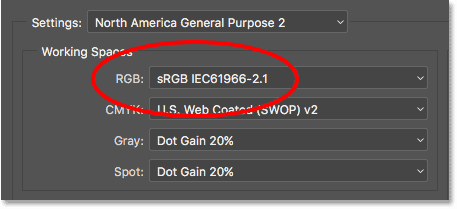
Photoshop'due south default working space for RGB is sRGB.
The sRGB Color Infinite
The sRGB color infinite was created back in 1996 by Hewlett-Packard and Microsoft. Information technology was designed as a standard based on the range of colors bachelor on a typical low-end computer monitor. Even today, most monitors can but brandish the sRGB range of colors. Considering of that, sRGB is the default color space for the web. Digital cameras typically have their default color space set to sRGB. In fact, many photographers are unaware that at that place's a Color Space option buried in their camera's carte. Your dwelling house inkjet printer is ready upward to receive sRGB images by default. And fifty-fifty commercial printing labs will usually wait you to relieve your images in the sRGB color infinite.
For all of these reasons, Adobe decided information technology was best to fix Photoshop's default RGB working space to sRGB. After all, sRGB is the safe choice. Merely the safe option isn't always the best choice. When information technology comes to image editing in Photoshop, "safety" and "best" are definitely not the same. The reason is that, of all the RGB color spaces we tin choose from, sRGB contains the smallest range of colors.
The Human Heart vs sRGB
To help illustrate the trouble, let's look at a graph. This graph shows the color range available to united states of america when working in the sRGB color infinite. The outer, curved surface area represents all the colors the human eye tin see. It's non a true representation considering it doesn't show brightness values. But information technology's still plenty to requite us a general sense of what's going on. Within the larger shape is a small triangle. The surface area within the triangle represents the sRGB color range. None of the colors outside the triangle are available in sRGB. This ways that many of the richer, more than saturated and more vibrant colors, particularly in the greens and cyans, are unavailable in the sRGB color space:
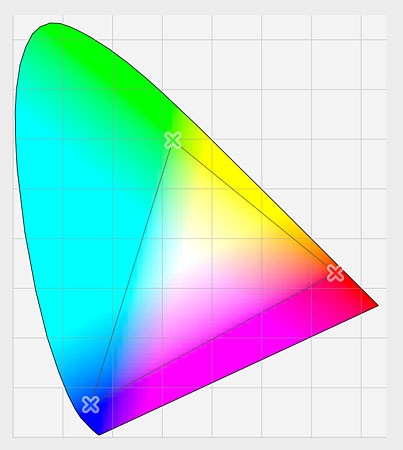
A graph showing the colors we tin see (outer shape ) and what sRGB tin can display (inner triangle).
The Adobe RGB Colour Space
While sRGB is by far the most widely-used RGB color space, it's not the only one. And, considering it offers the smallest range of colors, information technology's also non the best one. A better choice is Adobe RGB (1998). Created in 1998 past Adobe (which explains the name), Adobe RGB offers a wider range of colors than sRGB. It's original purpose was to help our photos look amend when printed. Even though printers can print far fewer colors than the number of colors available in sRGB, they can reproduce more than of the deeper, saturated colors our eyes are capable of seeing. Many higher-terminate inkjet printers have the option to switch from sRGB to the Adobe RGB color infinite and then our prints can benefit from the extended colour range.
Digital cameras are likewise capable of capturing far more than colors than what's available in sRGB. So many cameras these days, particularly high-cease DSLRs, accept the choice to alter their default colour infinite from sRGB to Adobe RGB. If y'all shoot JPEGs, Adobe RGB will allow your photos to preserve more of the scene's original colors. If your camera supports the raw format, and y'all capture your images as raw files, the Color Space setting in your photographic camera makes no difference. Raw files ever capture every color the camera sees. Nevertheless, Adobe Lightroom and Camera Raw, the tools we use to process raw images, both use Adobe RGB as their default RGB working space.
The Human Centre vs Adobe RGB
Let's look at some other graph, this time showing the range of colors bachelor in Adobe RGB. In one case over again, the outer shape represents all the colors we can encounter. The triangle inside the shape represents the range of colors Adobe RGB can reproduce. Notice how much larger the triangle is this time. While sRGB encompasses about a tertiary of the visible color range, Adobe RGB contains roughly half of all colors our eyes can come across. Nigh of the divergence is in the greens and cyans, as the triangle extends much further into those areas than information technology did with sRGB. Where the sRGB color infinite is limited to more than muted tones, Adobe RGB tin can produce richer, more vibrant colors:
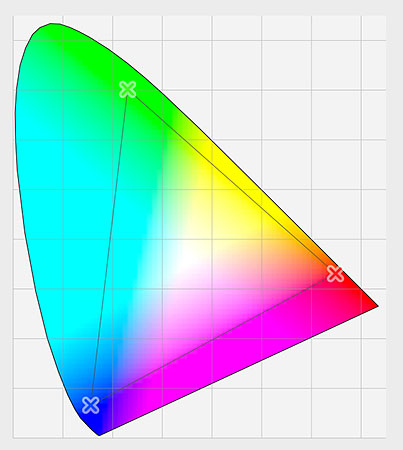
A similar graph showing the extended colour range of Adobe RGB.
Should Y'all Switch From sRGB To Adobe RGB?
Many digital cameras can capture images in Adobe RGB. Many inkjet printers tin can reproduce colors that are only available in Adobe RGB. There are even high-end computer monitors these days that can brandish nearly all of the Adobe RGB colour range. And so, should yous switch Photoshop's RGB working space from sRGB to Adobe RGB? In almost cases, the respond is yeah. Adobe RGB offers a much wider range of colors than sRGB. So if your camera can capture them and your printer can print them, why limit Photoshop to the smaller, more muted sRGB colour infinite?
Reasons For Choosing sRGB
There are a few reasons why yous may want to choose sRGB instead. As we learned earlier, sRGB is the safe choice. Computer monitors, cameras and inkjet printers are all prepare to sRGB by default. Besides, sRGB is the color space for images and graphics on the spider web. If you primarily display your photos online, yous may want to stick with sRGB. If you're a web designer, again sRGB may be a better choice. And, if you're make new to Photoshop and all this talk about color spaces is as well disruptive, at that place's no harm in leaving Photoshop set to sRGB. While sRGB may lack the more vibrant and saturated colors of Adobe RGB, it still contains a wide plenty colour range to produce stunning and amazing looking images.
Reasons For Choosing Adobe RGB
However, if y'all're a photographer and y'all want your photos to look their absolute all-time, particularly when printed, Adobe RGB is the better choice. If yous shoot in the raw format, both Camera Raw and Lightroom use Adobe RGB equally their default color infinite. Information technology makes sense, then, to fix Photoshop to Adobe RGB likewise. Even if you display your images on the web, there's no reason not to edit them in Adobe RGB. They'll benefit from the expanded Adobe RGB color range during the editing process. And, when you relieve them later using the Salvage for Spider web dialog box, Photoshop will automatically convert your images to sRGB. In other words, if you just desire to play information technology safe, cull sRGB. In pretty much every other case, Adobe RGB is the better choice.
Setting Photoshop To Adobe RGB
To start taking advantage of the expanded colour range of Adobe RGB, all we need to practice is modify Photoshop's RGB working space. Click on "sRGB IEC61966-two.one":
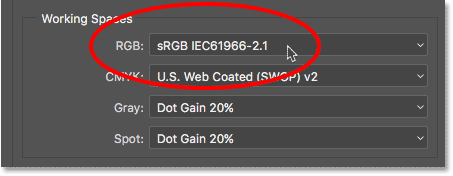
Clicking on the default sRGB color space.
So choose Adobe RGB (1998) from the list:
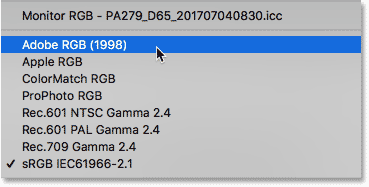
Choosing the Adobe RGB color infinite.
With that ane uncomplicated change, Photoshop volition now utilise Adobe RGB for displaying and editing your images. For best results, cheque your digital camera and inkjet printer to come across if they support the Adobe RGB color infinite. If they do, you'll want to set them both to Adobe RGB:
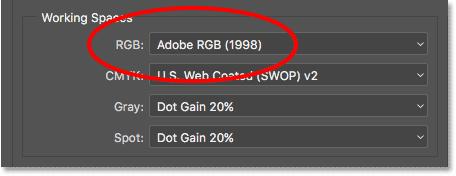
The RGB working infinite has been inverse to Adobe RGB.
The Color Management Policies
Now that we've fix Photoshop'south RGB working space to Adobe RGB, in that location's one set of options we should quickly expect at. Those are the Colour Management Policies. Even though we've set Photoshop to Adobe RGB, you may still find yourself opening images that were saved in sRGB. Information technology sounds like something to worry about, just it's not. Photoshop is more capable of handling images that use a color space other than our working space. By default, Photoshop will simply preserve the photo'south original color contour. This is exactly what yous want. The colors in the image will however look correct, and you lot can edit the image equally yous normally would without any issues.
We tell Photoshop how to handle these colour profile mismatches in the Color Direction Policies section. The RGB, CMYK and Grayness working spaces each accept their own separate setting. Again, the merely 1 we're actually interested in is the get-go 1, RGB. Still, it doesn't hurt to make sure that all three working spaces are set to Preserve Embedded Profiles, which they should be by default:
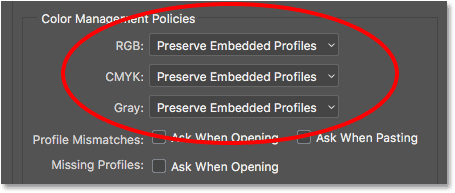
The Color Management Policies section.
The Profile Mismatches And Missing Profiles Checkboxes
Below the RGB, CMYK and Grayness options are 3 checkboxes. The kickoff two are for Profile Mismatches, where the image you're opening uses a color profile that'due south different from your working space. The third one is for Missing Profiles where the prototype has no color profile at all. Images downloaded from the web often exercise not take a color profile associated with them. If you select (bank check) these options, so every time you go to open an image with a different colour profile, or no contour at all, Photoshop will ask how you lot desire to handle it. To avoid the question and but let Photoshop open up the images as it normally would, leave these options unchecked:
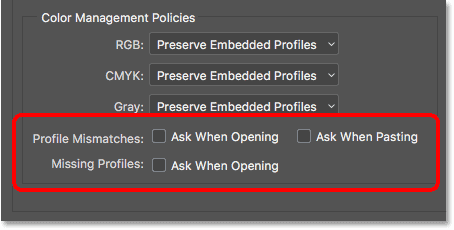
The Contour Mismatches and Missing Profiles options.
Save Your New Colour Settings
Once you've switched from sRGB to Adobe RGB, it's a practiced thought to save your new color settings. This style, y'all tin can easily switch back to them over again if needed. To save your color settings, click the Save push:
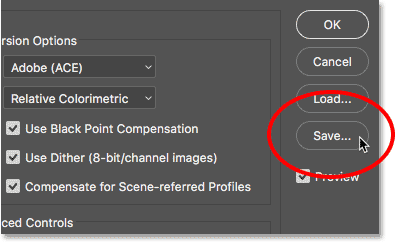
Clicking the Save button.
Enter a proper noun for your colour settings. I'll proper name mine "My Colour Settings". Then, click the Salvage button again:
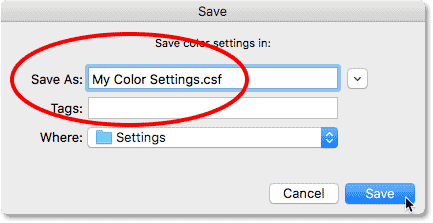
Naming the new color settings.
The Color Settings Comment dialog box volition open up. Here, yous can enter a description for your settings to serve equally a reminder of what these settings are for. I'll enter "These are the best settings to use with my images". Click OK when y'all're done to close out of the dialog box:
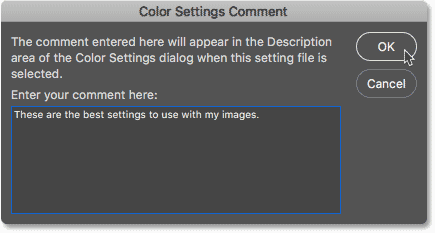
Calculation a description for the new color settings.
Your custom Photoshop color settings are at present saved. You can choose them over again at any fourth dimension from the Settings choice at the top of the Color Settings dialog box:
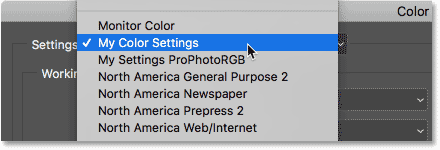
Selecting my new custom settings from the list of presets.
Where to become next...
And there we have it! That's how, and why, to switch your RGB working space in Photoshop from sRGB to Adobe RGB! If Photoshop is the only program you use in the Creative Deject (or Artistic Suite), this is all y'all need to practise. But if you employ other Adobe apps as well, like Illustrator or InDesign, you'll want to brand sure they're all using the same color settings. In the next lesson in this chapter, we'll learn how to sync Photoshop's color settings with all of your Creative Cloud or Creative Suite apps!
Or check out whatsoever of the other lessons in this chapter:
- 01. How to keep Photoshop CC up to date
- 02. How to install Adobe Bridge CC
- 03. How to download photos from your camera with Adobe Span
- 04. How to manage and organize your images with Adobe Span
- 05. Essential Photoshop Color Settings
- 06. Sync Photoshop's Colour Settings with all Creative Cloud apps
- 07. Essential Photoshop Preferences for beginners
- 08. How to reset Photoshop Preferences
For more capacity and for our latest tutorials, visit our Photoshop Basics section!
Other Stuff
© 2022 Photoshop Essentials.com.
For inspiration, not duplication.
Site design by Steve Patterson.
Photoshop is a trademark of Adobe Systems Inc.
Source: https://www.photoshopessentials.com/basics/color-settings/
Posted by: hannahexis1960.blogspot.com

0 Response to "How To Change To Rgb In Photoshop"
Post a Comment